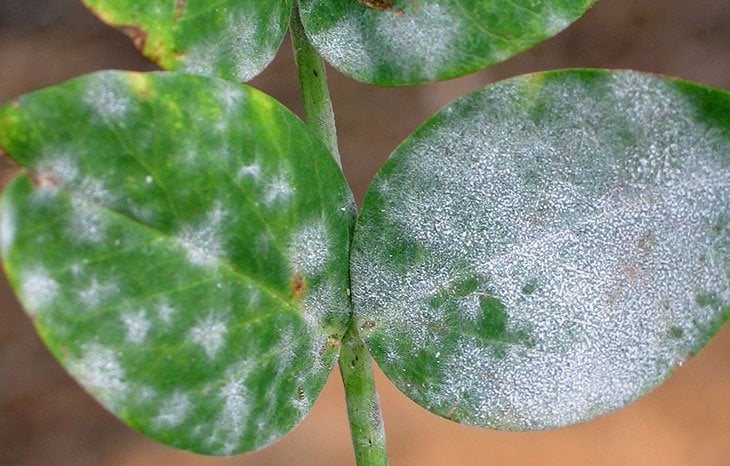Contents
- 1 Powdery Mildew on Indoor Plants (Easy Natural Fixes That Work Fast)
- 2 What Is Powdery Mildew?
- 3 Symptoms of Powdery Mildew on Indoor Plants
- 4 Causes of Powdery Mildew Indoors
- 5 Natural Ways to Treat Powdery Mildew
- 6 How to Prevent Powdery Mildew Indoors
- 7 Plants Most at Risk of Powdery Mildew
- 8 FAQs About Powdery Mildew on Indoor Plants
- 9 Final Thoughts on Powdery Mildew
- 10 Related Articles
Powdery Mildew on Indoor Plants (Easy Natural Fixes That Work Fast)
Powdery mildew is one of the most common fungal diseases that affect indoor plants. If you’ve noticed a white, powdery coating on your plant’s leaves, stems, or buds, it’s likely powdery mildew. While it can look alarming, the good news is that it’s treatable and preventable with the right steps. This guide will show you how to identify powdery mildew, treat it naturally, and stop it from coming back.
What Is Powdery Mildew?
Powdery mildew is a fungal infection caused by various fungi in the Erysiphales order. It appears as a white or gray powdery coating on leaves, stems, and buds. Unlike many other plant diseases, powdery mildew does not need water to spread—it thrives in warm, dry environments with poor airflow.
Symptoms of Powdery Mildew on Indoor Plants
White or gray powdery spots on leaves and stems
Leaves turning yellow or brown
Distorted, curled, or stunted growth
Premature leaf drop
If left untreated, powdery mildew weakens the plant and reduces its ability to photosynthesize.
Causes of Powdery Mildew Indoors
Poor air circulation around plants
High humidity without proper ventilation
Overcrowding of plants
Temperature fluctuations between day and night
Natural Ways to Treat Powdery Mildew
The best part is you don’t need harsh chemicals—there are natural remedies that work effectively.
1. Neem Oil Spray
Mix 2 teaspoons neem oil with 1 liter of water.
Spray directly on affected leaves once a week. Try this organic neem oil for plants on Amazon.
2. Baking Soda Solution
Mix 1 tablespoon baking soda, ½ teaspoon liquid soap, and 1 liter of water.
Spray affected areas weekly to prevent spreading.
3. Milk Spray
Mix 1 part milk with 2 parts water.
Spray every 10 days—milk proteins kill fungal spores in sunlight.
4. Remove Affected Leaves
Trim and dispose of heavily infected leaves.
Sterilize scissors before and after pruning.
How to Prevent Powdery Mildew Indoors
Space plants apart for better airflow.
Use a small fan to improve circulation.
Avoid watering leaves—water the soil directly.
Place plants where they get adequate light.
Don’t overcrowd plants on windowsills or shelves.
Plants Most at Risk of Powdery Mildew
African violets
Begonias
Roses
Herbs like basil and parsley
Succulents in poorly ventilated areas
FAQs About Powdery Mildew on Indoor Plants
Q: Is powdery mildew harmful to humans?
A: While it’s unsightly and harmful to plants, powdery mildew is generally not dangerous to humans. However, it may trigger allergies in sensitive individuals.
Q: Can I save a plant that has severe powdery mildew?
A: Yes, but it may take time. Remove heavily infected leaves, apply natural sprays consistently, and improve airflow around the plant.
Q: Will powdery mildew spread to all my indoor plants?
A: It can. That’s why it’s important to isolate infected plants immediately and treat them before returning them to their usual spot.
Q: Can I prevent powdery mildew completely?
A: You can significantly reduce the risk by ensuring good airflow, proper spacing, and avoiding overwatering. While no prevention is 100% foolproof, these practices keep your plants healthy and resilient.
Final Thoughts on Powdery Mildew
Powdery mildew may be one of the most common indoor plant problems, but it’s also one of the easiest to fix naturally. With simple sprays like neem oil, baking soda, or milk solutions, combined with better airflow and light, you can restore your plants quickly. Prevention is always the best cure—so keep your plants well-spaced, properly watered, and in the right environment.
By staying consistent with care, your indoor plants can thrive without the threat of powdery mildew coming back. Learn more about powdery mildew from the RHS powdery mildew guide.

